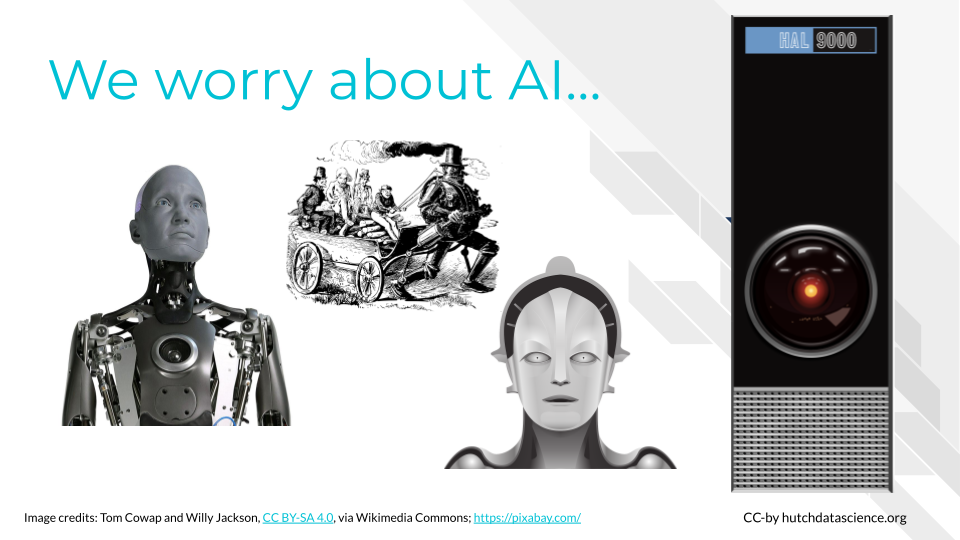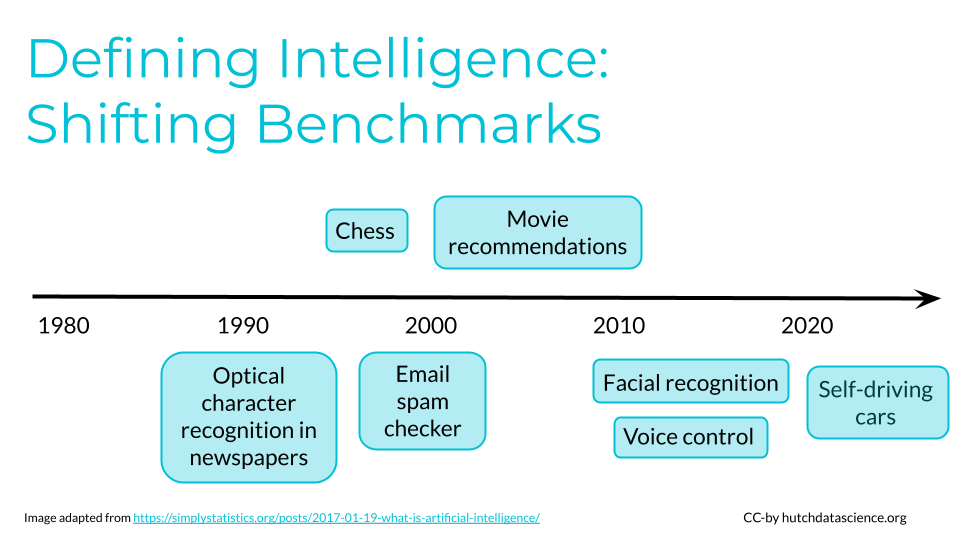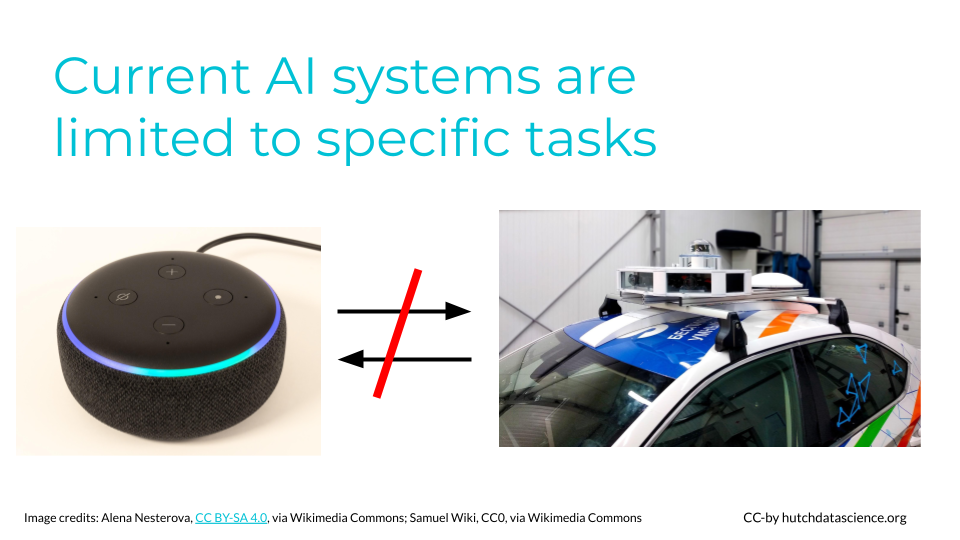
Chapter 5 What Is AI
When discussing artificial intelligence, people often envision humanoid robots, prompting concerns about their ability to outsmart us. The notion of robots passing tests that blur the line between human and machine, often depicted in science fiction, adds to these worries, particularly when considering the potential for AI systems to act in self-interest and make decisions independently.

Defining what AI is can be tricky because what experts consider to be AI changes frequently. John McCarthy, one of the leading early figures in AI once said, “As soon as it works, no one calls it artificial intelligence anymore”.
For instance, 20 years ago, the idea of an email spam checker was new. People were surprised that an algorithm could identify junk email accurately, and called it “artificial intelligence”. Since this type of algorithm has become so common, it is no longer called “artificial intelligence”. This transition happened because we no longer think it is surprising that computers can filter spam messages. Because it is not learning something new and surprising, it is no longer considered intelligent.

We often look at human intelligence the same way. For example, many years ago, only a few people knew how to use the internet. These people might have been considered extremely talented and intelligent. Now, the massive growth of online resources and social media mean that fluent internet use is almost required!
Scientists are still working toward computers with full human problem solving and cognition, or artificial general intelligence. We aren’t there yet. Currently, artificial intelligence systems are optimized to perform a specific task well, but not for general, multi-purpose tasks. For example, the AI application for recognizing voices can not be directly applied to drive cars, and vice versa. Similarly, a language translation app could not recognize images, and vice versa.

Artificial General Intelligence (AGI): A type of artificial intelligence that can understand, learn, and apply knowledge across a wide range of tasks, similar to the broad cognitive abilities of a human being. It represents the aspiration for machines to have versatile intelligence rather than focusing on specific, narrow domains. Check out Types of AI to learn more.
5.1 Our AI Definition
Going forward in this course, we define AI as having the following features:
Dataset: AI needs data examples that can be used to train a statistical or machine learning model to make predictions.
Algorithm: AI needs an algorithm, or a set of procedures, that can be trained based on the data examples. That way, it can take a new example and execute a human-like task. For instance, the algorithm learns which images feature a cat from pre-labeled images. When given a new image, it decides whether the image has a cat in it.
Interface: AI needs a physical interface or software for the trained algorithm to receive a data input and execute the human-like task in the real world. For example, you might interface with a chatbot in your web browser.

5.2 AI In Practice
The following are case studies that can help us conceptualize AI in the real world.
5.2.1 Amazon Recommendations
Amazon’s recommendation engine uses AI algorithms to analyze user behavior and past purchases, providing personalized product recommendations. This enhances the shopping experience, increases customer engagement, and drives sales.
TODO: Text here.
5.2.2 Financial Forecasting
In this case study, we will look at how artificial intelligence has been utilized in governmental financial services. National banks, such as the Federal Reserve of United States and the European Central bank of the European Union, have started to explore how Artificial Intelligence can be used for data mining and economic forecast prediction.
There are many uses of AI for improving financial institutions, each with potential benefits and risks. Most financial institutions weigh the benefits and risks carefully before implementation.
For instance, if a financial institution takes a high-risk prediction seriously, such as predicting a financial crisis or a large recession, then it would have huge impact on a bank’s policy and allows the bank to act early. However, many financial institutions are hesitant to take action based on artificial intelligence predictions because the prediction is for a high-risk situation. If the prediction is not accurate then there can be severe consequences. Additionally, data on rare events such as financial crises are not abundant, so researchers worry that there is not enough data to train accurate models (Nelson 2023).
Many banks prefer to pilot AI for low-risk, repeated predictions, in which the events are common and there is a lot of data to train the model on.
Let’s look at a few examples that illustrate the potential benefits and risks of artificial intelligence for improving financial institutions.
5.2.2.1 Categorizing Businesses

An important task in analysis of economic data is to classify business by institutional sector. For instance, given 10 million legal entities in the European Union, they need to be classified by financial sector to conduct downstream analysis. In the past, classifying legal entities was curated by expert knowledge (Moufakkir 2023).
Text-based analysis and machine learning classifiers, which are all considered AI models, help reduce this manual curation time. An AI model would extract important keywords and classify into an appropriate financial sector, such as “non-profits”, “small business”, or “government”. This would be a low-risk use of AI, as one could easily validate the result to the true financial sector.
5.2.2.2 Incorporating new predictors for forecasting

Banks are considering expanding upon existing traditional economic models to bring in a wider data sources, such as pulling in social media feeds as an indicator of public sentiment. The National bank of France has started to use social media information to estimate the public perception of inflation. The Malaysian national bank has started to incorporate new articles into its financial model of gross domestic product estimation. However, the use of these new data sources may may raise questions about government oversight of social media and public domain information (OMFIF 2023).
5.2.2.3 Using Large Language Models to predict inflation

The US Federal Reserve has researched the idea of using pre-trained large language models from Google to make inflation predictions. Usually, inflation is predicted from the Survey of Professional Forecasters, which pools forecasts from a range of financial forecasts and experts. When compared to the true inflation rate, the researchers found that the large language models performed slightly better than the Survey of Professional Forecasters (Federal Reserve Bank of St. Louis 2023).
A concern of using pre-trained large language models is that the data sources used for model training are not known, so the financial institution may be using data that is not in line with its policy. Also, a potential risk of using large language models that perform similarly is the convergence of predictions. If large language models make very similar predictions, banks would act similarly and make similar policies, which may lead to financial instability (OMFIF 2023).
5.3 What Is and Is Not AI
Let’s look at a few of examples. We can then decide whether or not the examples constitute AI.
5.3.1 Smartphones

The name “smartphone” implies these devices are making decisions and are powered by AI. Let’s consider our three criteria:
Dataset: Smartphones do collect a lot of data. For example, they retain your text messages and collect motion tracking information.
Algorithm: The smartphone as a whole does not usually get trained with this data. However, some features like virtual voice assistants and facial recognition do adapt given your data.
Interface: Again, some features like voice assistants can be interacted with through the smartphone.
While there are some features on smartphones that are powered by AI models, like virtual voice assistants and facial recognition, the device as a whole isn’t considered AI.
5.3.2 Calculators

Many of us use basic calculators, as you might find in Microsoft Excel, every day. AI also makes many calculations. Is it just a scaled-up calculator?
Dataset: Calculators and spreadsheets can store data.
Algorithm: Calculators do not generally use this data to train algorithms. The procedures that are performed (addition, subtraction, etc.) are almost always predefined. However, some AI-powered assistants are starting to be integrated into software like Excel and Google Sheets.
Interface: Calculators do meet the criteria for an interface, whether through a physical device or software application.
Traditional calculators are not considered AI, because they can only execute predefined operations.
5.3.3 Computer Programs

Like calculators, computers follow set procedures for problem solving and computation. Everyday computers use these procedures to help automate repetitive tasks and save time. However, this isn’t generally considered AI, because the computer’s algorithms aren’t being trained with new data you supply. AI systems exhibit the ability to adapt and handle new inputs for tasks that might be more complicated.
5.3.4 DISCUSSION Is It AI
Consider the following examples. Are they examples of AI? Why or why not? Click to expand and see the answer.
A smartfridge that lets you know when replacement parts are needed
This is not AI. The computer in the fridge is typically programmed to look for specific signs of wear or time passing. It is not typically trained with new data.
Speed cameras on the highway
Speed cameras on highways typically use specialized technology and are not explicitly powered by AI. These cameras are often equipped with radar sensors for measuring vehicle speed between checkpoints.
While the core functionality of speed cameras relies on sensor technology and predetermined speed thresholds, AI elements may be incorporated in some advanced systems. For example, AI could be used to enhance image recognition accuracy for reading license plates. However, the fundamental operation of speed cameras is rooted in sensor-based speed detection, not AI.Suggested accounts on Instagram
This is considered AI. Social media algorithms, like Instagram’s, make recommendations based on user behavior. For example, if you spend a lot of time viewing a page that was recommended, the system interprets that as positive feedback and will make similar recommendations. Typically, these recommendations get better over time as the user generates more user-specific data. You supply data through your behaviors, the algorithm gets trained, and you interact with the suggestions via the app.
5.4 Summary
The definition of artificial intelligence (AI) has shifted over time. We use the three part framework of data, algorithms, and interfaces to describe AI applications. You will need to consider specific technologies and whether they meet the criteria for being classified as AI using this framework. Adaptability and training with new data are key factors to keep in mind as we move further in the course.
Disclaimer: The thoughts and ideas presented in this course are not to be substituted for legal or ethical advice and are only meant to give you a starting point for gathering information about AI policy and regulations to consider.
